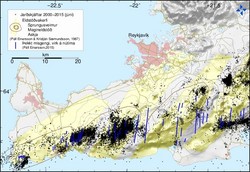Increased seismic activity between Krýsuvík and Ölfus
Information on recent earthquake activity in the eastern Reykjanes peninsula
In recent weeks, increased seismic activity has been detected on the Reykjanes peninsula, including a M4 earthquake in late May close to lake Kleifarvatn, which was felt widely in the capital region. Following such earthquakes, stress conditions in the shallow crust can be changed in the surrounding region.
An analysis of micro-earthquakes in the region indicates possible instabilities in the crust between lake Kleifarvatn (Krýsuvík) and Ölfus (the region of the 2008 earthquakes, close to Hveragerði). Deformation measurements in recent years also indicate possible stress accumulations in the region, which might be released as a larger earthquake. Historic recordings show that earthquakes in that region can be up to M6.5. The last earthquakes of M>6 were in 1929 and 1968. Both of these events caused no major damage in the capital area. In modern times, however, urban settlements have spread closer to historically active earthquake faults.
It can be expected that large earthquakes on the eastern Reykjanes peninsula will affect surrounding areas (capital region, Grindavík, Þorlákshöfn, Hveragerði and Reykjanesbær). Such earthquakes would be felt by all people in the affected area, many people might be frightened and leave their homes. Heavy furniture could be displaced and wall plastering might be damaged. Severe damage of well-built dwellings is not expected. The intensity of a large earthquake in this region can reach levels VI-VII on the Mercalli Scale.
It is important to regularly remind all inhabitants in seismically active regions about potential earthquake hazards. People should review their own security measures and preparedness for a large earthquake to minimize damage and possible injury. This includes homes and workplaces. Outdoors, the main hazards due to earthquakes are rockfalls in caves and landslides close to the epicentre.
Instructions on how to prepare for and react to an earthquake can be found on the web of the Icelandic Civil Protection agency. The photos in this video from ICESAR are informative as well:
A video from Landsbjörg, ICESAR, Icelandic Search and Rescue.




